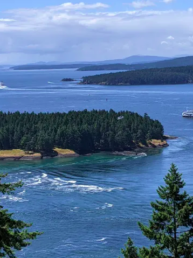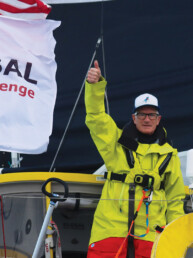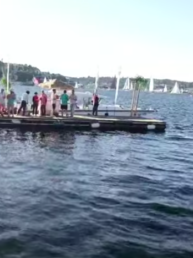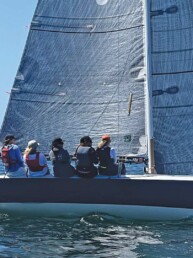From the June 2022 issue of 48° North.

Recently, a reader reached out for advice on getting the necessary skills and knowledge for a small boat journey. His questions made me reflect on my own history and experience in sailing, which lacked charts or maps. When I first got interested in small craft, I noticed that boat owners seemed to possess a mysterious aura of knowledge. I could purchase a boat easily enough from Craigslist, I realized. But how to know if I was choosing the right one for my particular skills and goals? And how would I learn to pilot it? These were murky questions indeed.
While looking to acquire a boat, I started to wonder if boaters are simply born fully formed, ready to grab a tiller and go. It sure seemed that way. Bridging the gap between watching a boat joyfully tacking on the river and actually getting behind the mast myself felt more challenging than I expected.
I cruised the internet and found opportunities to take classes on keelboats; but the idea of starting with something so big and expensive was not only financially prohibitive, but daunting. Taking on a keelboat would be like going from tricycle riding directly to driving a semi-truck: completely overwhelming.
Visiting the annual Portland Boat Show, I wandered the convention center’s cavernous halls, passing motorized fishing craft, bulky pontoon boats, and a towering sailboat high atop a specialized trailer. I was starting to despair, when in the very back of the hall, I spotted a delegation from the Willamette Sailing Club standing next to several knee-high vessels. This felt much more approachable.
I learned that the club focused on one-design dinghies and offered a US Sailing small boat course covering the basics, with an on-the-water component. (I still remember a note in the course description stating that participants should be prepared to get wet.) I signed up and started to discover the visceral magic of motion that comes from harnessing the wind. It was a solid start and showed me that sailing was something I had a passion for.
I played in a variety of small fiberglass boats, eventually purchasing a 1973, baby blue Lido 14. Known as a family racing dinghy, it was fun but after learning to hike out, race around the marks (and indeed, get wet), I wanted to go farther, see new places, and have adventures beyond the small patch of my home river where the club raced. Camp cruising wasn’t part of the curriculum, though, nor was there much interest in it from most club members. My career as a small boat cruiser was paused, but not stopped.

I looked into a US Sailing basic cruising class, but it assumed I’d be operating a 23-32 foot sloop-rigged keelboat with auxiliary power. I was yet to learn that, in addition to the seemingly ubiquitous Marconi rig, there were loose-footed lugsails, sprit sails, and high-peaked gaff sails, too. Yet, there was no course for a boat with such a rig, nor was there any assumption that oars, sculls, or paddles should be in the class syllabus. Nothing seemed farther from the reality of my 14-foot open boat.
Looking back, if I could have scaled the class outline down to trailer-sailer size, it would actually have covered much of what I needed to know: operating the boat’s rigging and systems, leaving and returning to a dock or anchorage, boat handling, heavy weather sailing, safety, and navigation.

Instead of taking the class, I started checking out library books about kayak touring, canoe travel, and seamanship, gleaning what I could apply to my own situation. The best thirteen dollars I spent was on Ray Killen’s Simple Kayak Navigation, which taught me how to read a chart and use a compass from a foot above the water. And I experimented. I packed all my backpacking gear into dry bags and attempted to stuff them in my racing dinghy. I sailed far beyond the marks on my home river. I tried moving my boat with a paddle. I bought a small row boat and rowed until I’d built strong core muscles and grown calluses on my hands. I went to Traditional Small Craft Association messabouts. And I asked questions of more experienced sailors — lots of questions.
Luckily, I stumbled on the community of small boat sailors who post at the online WoodenBoat Forum, where people welcomed me and even responded thoughtfully to my rookie questions. The forum hosted discussions about cockpit tents, correct lengths for oars, and multi-day cruises on boats you could tow with the family car. And of course, there were the inevitable debates about the best anchor, too.
Over time, I did drills to see how fast I could set and strike my sails. I capsized the boat on purpose and figured out how to climb back in and bail it out. I sailed a lot, with the intention of getting to know every inch of my boat, so I could take it apart and put it back together again in the dark. I tried to memorize every knot in the book, eventually settling for intimately knowing five or six that met all my needs.
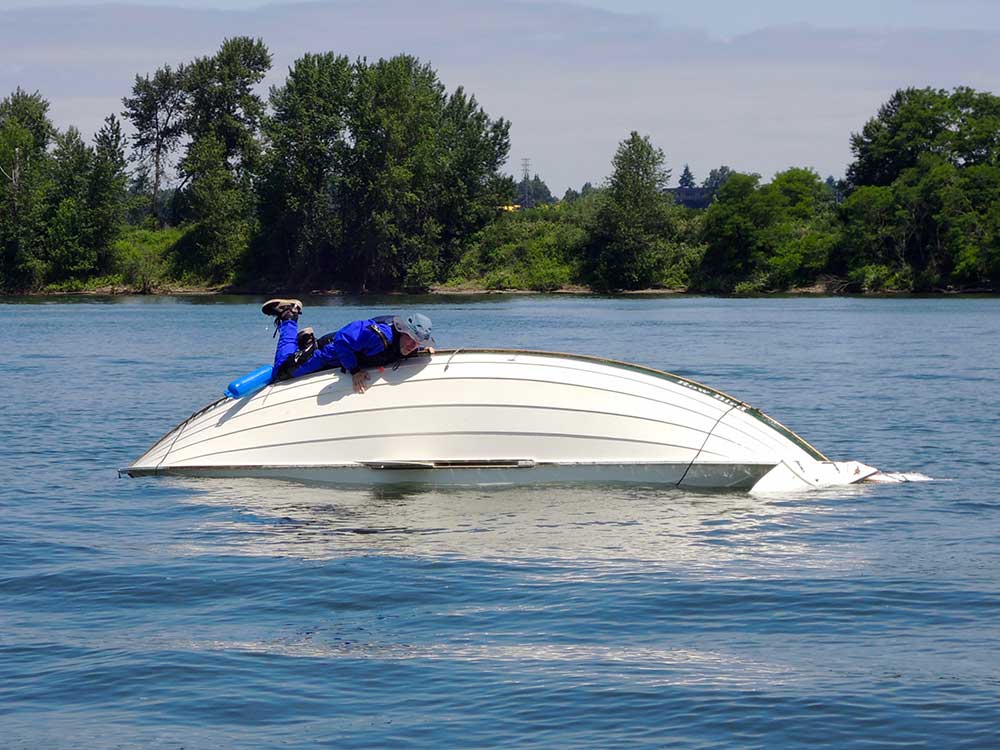
I learned about tides and currents incrementally, by taking more and more challenging day trips, before working my way up to overnighters, and eventually multi-day journeys. Slow to learn, but methodical, I tried to incorporate something new into each voyage.
Mistakes? There were lots of them: shackle pins dropped into the water, untended oars that abandoned ship, water pouring over the gunwale when I was over canvassed; and several fights against adverse currents, because I failed to read the tide atlas properly.
Any good journey has many routes to a successful conclusion. Each sailor must evaluate their equipment and skill level, then consider that dreamed-of destination beckoning over the horizon, and continuously work into the unknown. They must seek as many sources as possible to learn more. Finally, every sailor must be willing to push themselves, even if that leads to initial failure. There are no right or wrong directions, only the ones that fulfill, and perhaps get you home again in one piece with the desire to get back out on your next sailing adventure.
Bruce Bateau sails and rows traditional boats with a modern twist in Portland, Oregon. His stories and adventures can be found at www.terrapintales.wordpress.com.
Bruce Bateau
Bruce Bateau sails and rows traditional boats with a modern twist in Portland, Ore. His stories and adventures can be found at www.terrapintales.wordpress.com

